Related Research Articles

The Armed Forces of Yemen are the military forces of the Republic of Yemen. They include the Yemeni Army, Yemeni Navy and the Yemeni Air Force. The capital of the country, Sana’a is where the military is headquartered. Per the constitution of Yemen, the President of Yemen serves as the commander-in-chief.
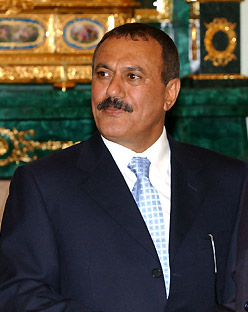
Ali Abdullah Saleh al-Ahmar was a Yemeni politician who served as the first President of Yemen, from Yemeni unification on 22 May 1990, to his resignation on 25 February 2012, following the Yemeni Revolution. Previously, he had served as President of the Yemen Arab Republic, or North Yemen, from July 1978, to 22 May 1990, after the assassination of President Ahmad al-Ghashmi.

The Houthi insurgency, also known as the Houthi rebellion, the Sa'dah War, or the Sa'dah conflict, was a military rebellion pitting Zaidi Shia Houthis against the Yemeni military that began in Northern Yemen and has since escalated into a full-scale civil war. The conflict was sparked in 2004 by the government's attempt to arrest Hussein Badreddin al-Houthi, a Zaidi religious leader of the Houthis and a former parliamentarian on whose head the government had placed a $55,000 bounty.

Yahia Badreddin al-Houthi is the political leader of the Zaidi rebels, known as the Houthis, who are fighting against the government of Yemen. He is a brother of current Houthi leader Abdul-Malik, late Houthi leader Hussein, Muhammad, Ibrahim, Abdulkhalik, and Abdul-Karim.
Hussein Badreddin al-Houthi was a Yemeni Zaidi religious, political and military leader, as well as former member of the Yemeni parliament for the Party of Truth between 1993 and 1997. He was instrumental in the Houthi insurgency against the Yemeni government, which began in 2004. Al-Houthi, who was a one-time rising political aspirant in Yemen, had wide religious and tribal backing in northern Yemen's mountainous regions. The Houthi movement took his name after his assassination in 2004.

The Houthi movement, officially known as Ansar Allah, is a Shia Islamist political and military organization that emerged from Yemen in the 1990s. It is predominantly made up of Zaidi Shias, with their namesake leadership being drawn largely from the Houthi tribe.
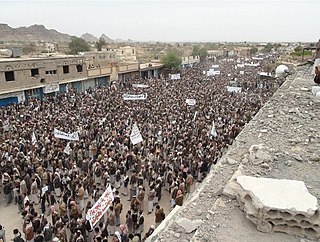
The Battle of Saada was a military confrontation that erupted in March 2011 between Houthi rebels and tribal forces loyal to Yemeni President Ali Abdullah Saleh in the northern city of Saada. Following days of heavy clashes, the Houthis managed to capture the entire Saada Governorate including its provincial capital and established an independent administration, thereby marking the first such Yemeni governorate to fall out of central government control since the nationwide uprising began in 2011. Saada later becomes known as the Houthi stronghold since its takeover.
Operation Scorched Earth was the code-name of a Yemeni military offensive in the Saada Governorate that began in August 2009. It marked the fifth wave of violence during the ongoing insurgency by the Houthis against the government. In November 2009, the conflict spread across the border into neighboring Saudi Arabia. This conflict led to the Saudi military's incursion into Yemen, marking the first military operation conducted by Saudi Arabia since 1991.

Iran and Yemen have had cordial, if tepid, relations since the Iranian Revolution in 1979. Ties between the Saudi-backed Yemeni government in Aden, however, have been damaged in recent years by Iran's support for the rival Yemeni government in Sanaa linked to the Houthi movement. Since 2019, Iran has recognized the Supreme Political Council as the sole legitimate government of Yemen.

The siege of Dammaj began in October 2011 when the Houthis, a Zaydi-led rebel group which controls the Sa'dah Governorate, accused Salafis loyal to the Yemeni government of smuggling weapons into their religious center in the town of Dammaj and demanded they hand over their weapons and military posts in the town. As the Salafis refused, Houthi rebels responded by imposing a siege on Dammaj, closing the main entrances leading to the town. The town was controlled by the Houthis and the fighting was mainly centered at Dar al-Hadith religious school, which was operated by Salafis.

The Houthi takeover in Yemen, also known as the September 21 Revolution, or 2014–15 coup d'état, was a popular revolution against Yemeni President Abdrabbuh Mansur Hadi led by the Houthis and their supporters that pushed the Yemeni government from power. It had origins in Houthi-led protests that began the previous month, and escalated when the Houthis stormed the Yemeni capital Sanaa on 21 September 2014, causing the resignation of Prime Minister Mohammed Basindawa, and later the resignation of President Abdrabbuh Mansur Hadi and his ministers on 22 January 2015 after Houthi forces seized the presidential palace, residence, and key military installations, and the formation of a ruling council by Houthi militants on 6 February 2015.
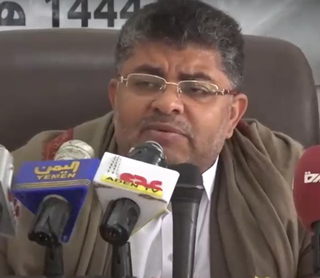
Mohammed Ali al-Houthi is a Yemeni political figure who is the former President of the Revolutionary Committee or Revolutionary Council, a body formed by Houthi militants and the de facto President of Yemen. He was one of the military field commanders who led the group's seizure of the Yemeni capital Sana’a in September 2014, and eventually became the de facto leader of Yemen after the Houthi takeover of the Yemeni government in 2015. He is a cousin of Abdul-Malik Badreddin al-Houthi, the group's leader.

The Yemeni Crisis began with the 2011–2012 revolution against President Abdullah Saleh, who had led Yemen for 33 years. After Saleh left office in early 2012 as part of a mediated agreement between the Yemeni government and opposition groups, the government led by Saleh's former vice president, Abdrabbuh Mansur Hadi, struggled to unite the fractious political landscape of the country and fend off threats both from Al-Qaeda in the Arabian Peninsula and from Houthi militants that had been waging a protracted insurgency in the north for years.
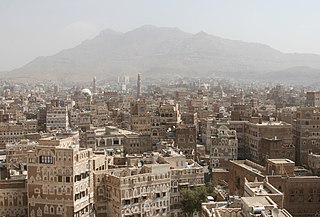
The Battle of Sanaa in 2014 marked the advance of the Houthis into Sanaa, the capital of Yemen, and heralded the beginning of the armed takeover of the government that unfolded over the following months. Fighting began on 9 September 2014, when pro-Houthi protesters under the command of Abdul-Malik al-Houthi marched on the cabinet office and were fired upon by security forces, leaving seven dead. The clashes escalated on 18 September, when 40 were killed in an armed confrontation between the Houthis led by military commander Mohammed Ali al-Houthi and supporters of the Sunni hardliner Islah Party when the Houthis tried to seize Yemen TV, and 19 September, with more than 60 killed in clashes between Houthi fighters and the military and police in northern Sanaa. By 21 September, the Houthis captured the government headquarters, marking the fall of Sanaa.

The aftermath of the Houthi takeover in Yemen refers to developments following the Houthis' takeover of the Yemeni capital of Sana'a and dissolution of the government, which eventually led to a civil war and the Saudi Arabian-led intervention in Yemen.
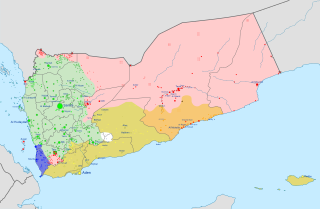
The Yemeni civil war is an ongoing multilateral civil war that began in late 2014 mainly between the Rashad al-Alimi-led Presidential Leadership Council and the Mahdi al-Mashat-led Supreme Political Council, along with their supporters and allies. Both claim to constitute the official government of Yemen.

On 26 March 2015, Saudi Arabia, leading a coalition of nine countries from West Asia and North Africa, launched an intervention in Yemen following a new joint request from Yemeni president Abdrabbuh Mansur Hadi for military support after his forces were ousted from Sanaʽa by Houthi insurgents during the Yemeni Civil War. Government forces, Houthi rebels, and other armed groups fought after the draft constitution and power-sharing arrangements collapsed, despite progress made by the UN during the political transition at that time. Violence escalated in mid-2014. Houthis and allied insurgents seized control of Sana'a in September 2014 and thereafter. In response, President Hadi asked Saudi Arabia to intervene against the Iranian-backed Houthis.

The siege of Taiz is an ongoing, protracted military confrontation between opposing Yemeni forces in the city of Taiz for control of the city and surrounding area. The battle began one month after the start of the Yemeni Civil War.
The following is a timeline of the Yemeni civil war, which began in September 2014.

The Battle of Marib is an ongoing battle that erupted since February 2021 following the advance of the Houthis towards the city of Marib, the capital of Marib Governorate in Yemen controlled by the Cabinet of Yemen.
References
- 1 2 Rebellion continues Archived 2005-10-24 at the Wayback Machine Al-Ahram Weekly
- ↑ 27 killed as Yemeni troops overrun rebel stronghold Arab News
- ↑ Aide to Yemeni rebel cleric surrenders Arab News
- ↑ Rules of engagement Archived May 12, 2007, at the Wayback Machine Arab News